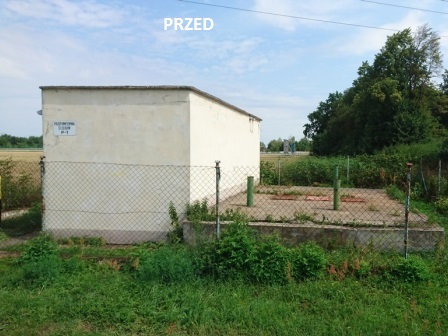
Old main pumping station 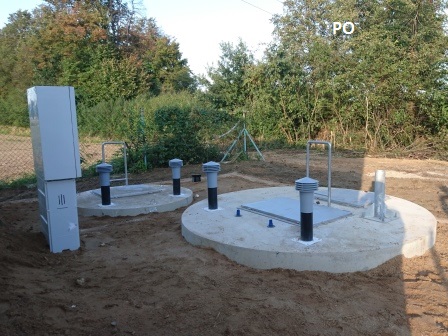
New tanks and equipment 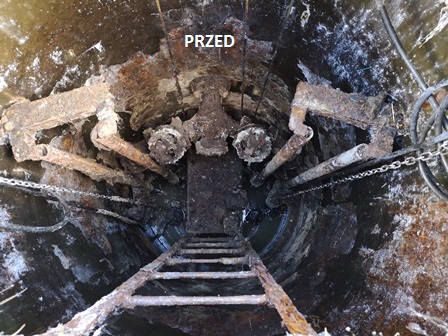
Old steel pumping station 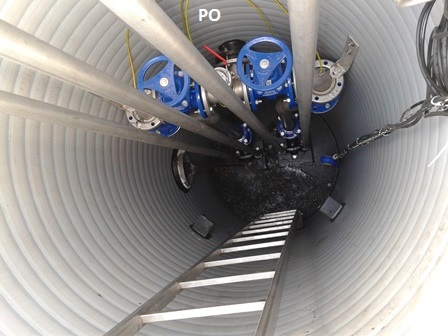
After modernization
Modernization of pumping stations or their replacement – what to choose?
There are many pumping stations on the market that have their glory years behind them and for many reasons are not doing their job properly. In order to restore their efficiency, sometimes you only need to replace the pumps with new ones, sometimes replace the control, sometimes you need to replace or repair the discharge pipelines and in extreme cases you need to take care of the technical condition of the tank. Due to such problems of conservators of sewage pumping stations, Metalchem-Warszawa implements broadly understood modernizations of pumping stations, which may include:
- delivery / replacement of pumps,
- replacement of piping inside the tank,
- replacement of shut-off and return fittings
- controlbox replacement,
- tank replacement
- replacement of pressure pipeline sections,
- unblocking the flow in pumping stations,
- installing basket grates at the inlet to the tank,
- assembly of cranes or gates for pulling out pumps,
- additional equipment installations
Delivery or replacement of pumps – when modernizing pumping stations, we can leave the old user’s pumps, if they are still in good condition, e.g. replace all piping. We will then adapt the pumps to the new equipment. However, if the pumps need to be replaced, we either give new ones with the same hooks or make the appropriate adapters to fit the old coupling elbow. Of course, everything is easiest to do on components produced by Metalchem-Warszawa S.A.
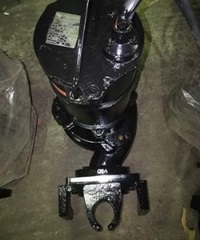
Manufacturer’s hitch X 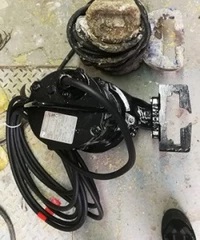
Manufacturer’s hitch Y 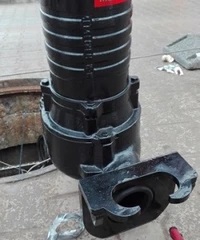
Manufacturer’s hitch Z
Replacement of piping inside the tank – cutting out old risers, discharge manifold and adjusting the new piping made of stainless steel or PE to the existing pumping station. In most cases, it is better to do the equipment of the pumping station again than to adjust individual elements to old fittings, especially how old pipes were welded at assembly on site.
Replacement of fittings – Rubber wedge valves and non-return valves (most often ball) after many years in an aggressive sewage environment require replacement, fortunately their dimensions are standardized and their replacement is not a big problem.
Replacement of the control switchboard – Control cabinets are rarely subject to modernization, rather they are exchanges for completely new systems with new possibilities and a wider scope of work. All assumptions are initially agreed with the customer and then we deliver to the construction site a properly configured switchboard ready for connection of pumps and commissioning. Care should be taken to properly separate the gases emitted from the pumping station from the electronic components in the switchboard, so that the system is not exposed to an aggressive sewage environment and does not cause ignition accumulated in the sewage, e.g. methane.
Replacement of the tank – In the event of problems with the tightness of the tank or its mechanical strength, it is necessary to replace it. Our company performs modernization of the pumping station, most often in two ways: by replacing the entire pumping station one to one or inserting a new tank into the old jacket.
When replacing one to one, we bring a new tank to the construction site and, if it is possible, we place it next to the old pumping station, equip the interior and cut off the inflow and pumping. This procedure requires a lot of earthworks but allows the old pumping station to work until it is connecting and the pause time for pumping is very short. Sometimes the old pumping station is used as the primary settling tank, which aims to stop the largest garbage flowing into the pumping station and which may clog the pumping system.
If the new pumping station tank must stand in exactly the same place, we try to provide alternative pumping, so-called bypass bypassing the pumping station during works. However, it should be remembered that such bypass requires constant control, because it is a temporary system and will never replace a real pumping station. After starting the flow around the pumping station, we proceed to empty the tank of sewage and equipment and then dig up the old tank and place a new one in its place. After equiped, the inflow and discharge are connected and connected back to the pumping station. It is a time-consuming and expensive operation, but it allows you to work calmly without excessive haste.
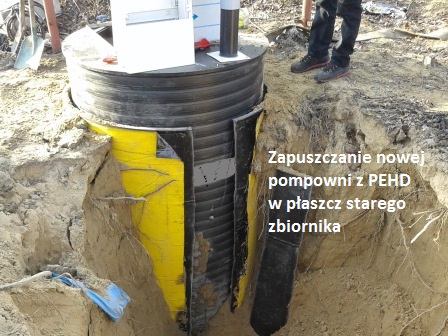
Entering a new tank into the old – Many old pumping stations designed 20-30 years ago had oversized tanks assuming a large increase in the inflow of sewage in the future. Our specialists always check the current demand of the pumping station and analyze the possibilities of using a smaller pumping station with appropriate parameters. Thanks to this, in many cases modernization of the pumping station, it was possible to insert a new tank with a smaller diameter into the jacket of the old pumping station (treated only as a trench cover).
Depending on the situation and the terms of the order, we insert concrete or polymer concrete tanks and then arm and put into operation or bring to the construction site a complete assembled pumping station made of PEHD or TWS and let into the mantle of the old tank. Such operations are much faster, much cheaper to perform and do not require such complex earthworks as the foundation of new pumping stations. Usually, after preparing everything with us in the company, field work takes 1-2 business days.
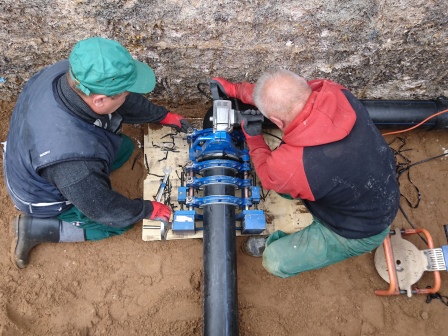
Replacement of pressure pipelines – Modernization of sewage pumping stations is often associated with its foundation next to the old tank or requires relocation of fragments of pipelines entering and leaving the pumping station. Metalchem-Warszawa S.A. company also provides services in this area. We make pipeline connections, including steel, PVC or PE.
Clearing the flow – During our site visits, customers-operators often complain of problems with the flow of sewage in pumping stations. The most frequently mentioned problems include:
- pump clogging,
- blocking flow in internal pipelines (risers),
- flow constriction in pressure pipelines,
- fat increase in the pumping station,
- accumulation of thick deposits in the tank.
Clogging of pumps is usually solved by replacing pumps with too small passages or with shredders for pumps of our production with Vortex impellers and free passage at least 50mm and even better 80mm. Also, increasing the pump power by 1-2kW allows you to increase the pump starting torque and increases resistance to blocking the impeller with rags or waste contained in the wastewater.
Blocking of risers usually occurs when pipelines are improperly made, where there are burrs on the inside of the welds or when the risers have a smaller diameter than the passage through the pumps. Then it is necessary to consider replacing the risers with new ones or making new pumping station equipment with a larger diameter, if the pressure pipeline behind the pumping station allows it.
The restriction of the flow in the pressure pipeline may be caused by bending / crushing the pipe, improper connection of various types of pipes or improperly selected speed of sewage flow causing slow overgrowth of the pipeline and narrowing its cross-section. We analyze each case separately based on the technical knowledge and vast experience of our employees. Among other things, that’s why our control takes into account every 10th cycle the activation of two pumps simultaneously to increase the flow and self-cleaning of the pressure pipeline. Sometimes it is necessary to increase the power of pumps, although quantitative calculations of the inflow of sewage do not indicate this, but it is necessary to maintain an appropriate speed of lifting sand and sludge in the pipes.
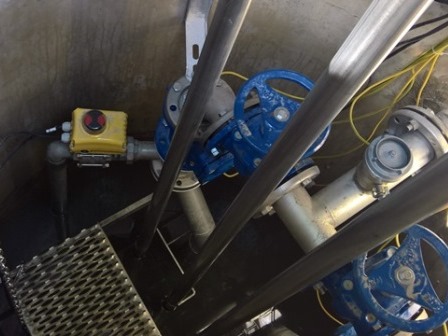
Fat growth, i.e. a sheepskin coat consisting of fats and sewage foam that stays on the surface of the medium and sticks to all its elements. Over time, this mixture creates lumps of considerable size that can affect the operation of the pumping station by, for example, blocking float switches or blocking the pump inlet. Scum deposits can be prevented by using either fat separators in front of the pumping station or by cyclic, dynamic mixing of the medium in the entire volume of the tank. Special manual or automatic rinsing cycles are used, e.g. MASP by Metalchem-Warszawa S.A.
The accumulation of sediments at the bottom of the reservoir reduces its retention surface and over time the pumps become clogged with thick sludge impeding flow in the pipes. To ensure a smooth exchange of the medium in the tank and reduce the frequency of cleaning of pumping stations from sand by specialized slurry tankers, also in this case manual or automatic rinsing systems (MASP) are used.
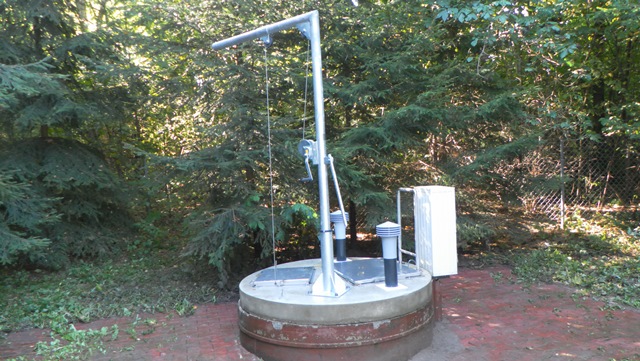
The installation of basket grates allows to reduce the falling into the pumping station of larger garbage carried by sewage such as rags, mops or pieces of wood. We install the gratings in the inflow pumping station, lower them and pull them out using a manual crane along the pipe guides. Metalchem-Warszawa S.A. they have an open bottom for easy emptying above the screenings containers.
The installation of davits is a considerable simplification for service because of the weight of the pumps or the screens filled with screens. Manual davits do not require special permits or supervision. It is also possible to install the crane base itself and the mobile crane is transported by a crane from one pump station to another, which reduces the risk of its theft.
Additional equipment for sewage pumping stations includes:
- flowmeter,
- aeration and vent valve,
- valves at the inflow,
- biofilters absorbing odors from pumping stations,
- manhole opening sensors,
- hydrogen sulfide or methane sensors,
- chemistry dosing stations for wastewater,
- tank covering from the inside with resin,
- gate valves with electric drive with control,
- other unusual solutions to be agreed with the customer.
